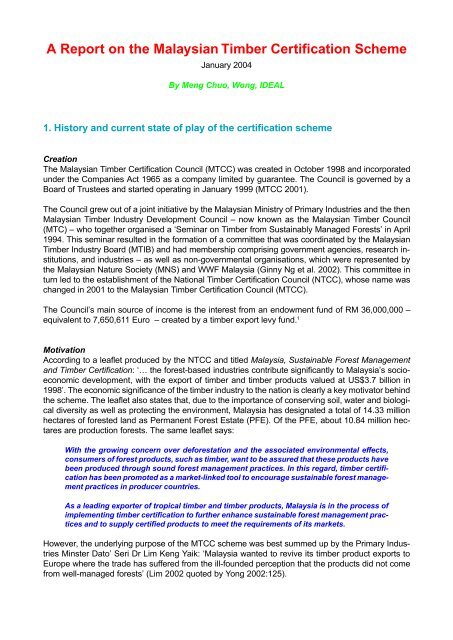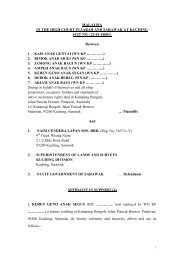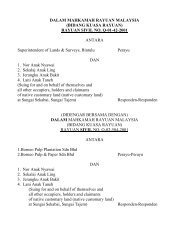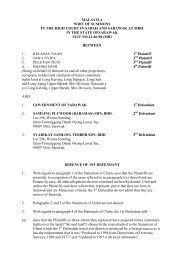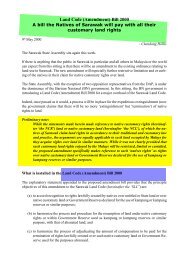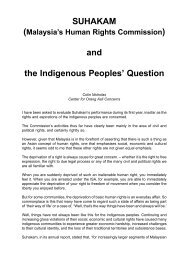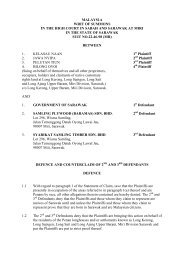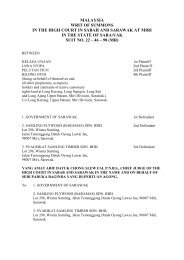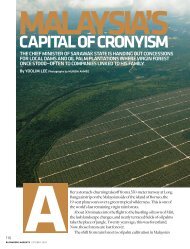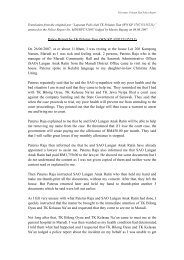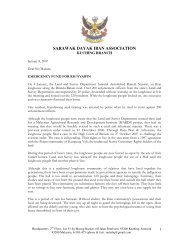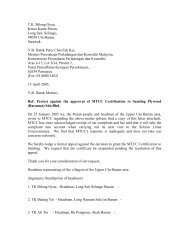A Report on the Malaysian Timber Certification Scheme - Rengah ...
A Report on the Malaysian Timber Certification Scheme - Rengah ...
A Report on the Malaysian Timber Certification Scheme - Rengah ...
Create successful ePaper yourself
Turn your PDF publications into a flip-book with our unique Google optimized e-Paper software.
A <str<strong>on</strong>g>Report</str<strong>on</strong>g> <strong>on</strong> <strong>the</strong> <strong>Malaysian</strong> <strong>Timber</strong> Certificati<strong>on</strong> <strong>Scheme</strong><br />
January 2004<br />
By Meng Chuo, W<strong>on</strong>g, IDEAL<br />
1. History and current state of play of <strong>the</strong> certificati<strong>on</strong> scheme<br />
Creati<strong>on</strong><br />
The <strong>Malaysian</strong> <strong>Timber</strong> Certificati<strong>on</strong> Council (MTCC) was created in October 1998 and incorporated<br />
under <strong>the</strong> Companies Act 1965 as a company limited by guarantee. The Council is governed by a<br />
Board of Trustees and started operating in January 1999 (MTCC 2001).<br />
The Council grew out of a joint initiative by <strong>the</strong> <strong>Malaysian</strong> Ministry of Primary Industries and <strong>the</strong> <strong>the</strong>n<br />
<strong>Malaysian</strong> <strong>Timber</strong> Industry Development Council – now known as <strong>the</strong> <strong>Malaysian</strong> <strong>Timber</strong> Council<br />
(MTC) – who toge<strong>the</strong>r organised a ‘Seminar <strong>on</strong> <strong>Timber</strong> from Sustainably Managed Forests’ in April<br />
1994. This seminar resulted in <strong>the</strong> formati<strong>on</strong> of a committee that was coordinated by <strong>the</strong> <strong>Malaysian</strong><br />
<strong>Timber</strong> Industry Board (MTIB) and had membership comprising government agencies, research instituti<strong>on</strong>s,<br />
and industries – as well as n<strong>on</strong>-governmental organisati<strong>on</strong>s, which were represented by<br />
<strong>the</strong> <strong>Malaysian</strong> Nature Society (MNS) and WWF Malaysia (Ginny Ng et al. 2002). This committee in<br />
turn led to <strong>the</strong> establishment of <strong>the</strong> Nati<strong>on</strong>al <strong>Timber</strong> Certificati<strong>on</strong> Council (NTCC), whose name was<br />
changed in 2001 to <strong>the</strong> <strong>Malaysian</strong> <strong>Timber</strong> Certificati<strong>on</strong> Council (MTCC).<br />
The Council’s main source of income is <strong>the</strong> interest from an endowment fund of RM 36,000,000 –<br />
equivalent to 7,650,611 Euro – created by a timber export levy fund. 1<br />
Motivati<strong>on</strong><br />
According to a leaflet produced by <strong>the</strong> NTCC and titled Malaysia, Sustainable Forest Management<br />
and <strong>Timber</strong> Certificati<strong>on</strong>: ‘… <strong>the</strong> forest-based industries c<strong>on</strong>tribute significantly to Malaysia’s socioec<strong>on</strong>omic<br />
development, with <strong>the</strong> export of timber and timber products valued at US$3.7 billi<strong>on</strong> in<br />
1998’. The ec<strong>on</strong>omic significance of <strong>the</strong> timber industry to <strong>the</strong> nati<strong>on</strong> is clearly a key motivator behind<br />
<strong>the</strong> scheme. The leaflet also states that, due to <strong>the</strong> importance of c<strong>on</strong>serving soil, water and biological<br />
diversity as well as protecting <strong>the</strong> envir<strong>on</strong>ment, Malaysia has designated a total of 14.33 milli<strong>on</strong><br />
hectares of forested land as Permanent Forest Estate (PFE). Of <strong>the</strong> PFE, about 10.84 milli<strong>on</strong> hectares<br />
are producti<strong>on</strong> forests. The same leaflet says:<br />
With <strong>the</strong> growing c<strong>on</strong>cern over deforestati<strong>on</strong> and <strong>the</strong> associated envir<strong>on</strong>mental effects,<br />
c<strong>on</strong>sumers of forest products, such as timber, want to be assured that <strong>the</strong>se products have<br />
been produced through sound forest management practices. In this regard, timber certificati<strong>on</strong><br />
has been promoted as a market-linked tool to encourage sustainable forest management<br />
practices in producer countries.<br />
As a leading exporter of tropical timber and timber products, Malaysia is in <strong>the</strong> process of<br />
implementing timber certificati<strong>on</strong> to fur<strong>the</strong>r enhance sustainable forest management practices<br />
and to supply certified products to meet <strong>the</strong> requirements of its markets.<br />
However, <strong>the</strong> underlying purpose of <strong>the</strong> MTCC scheme was best summed up by <strong>the</strong> Primary Industries<br />
Minster Dato’ Seri Dr Lim Keng Yaik: ‘Malaysia wanted to revive its timber product exports to<br />
Europe where <strong>the</strong> trade has suffered from <strong>the</strong> ill-founded percepti<strong>on</strong> that <strong>the</strong> products did not come<br />
from well-managed forests’ (Lim 2002 quoted by Y<strong>on</strong>g 2002:125).
Target groups<br />
The <strong>Malaysian</strong> <strong>Timber</strong> Certificati<strong>on</strong> Council scheme is targeted at forest managers and at timber<br />
product manufacturers and exporters.<br />
Certified forest management units<br />
As of October 2003, seven states – out of a total of<br />
13 states – have been certified. In December 2001 As of October 2003, seven<br />
<strong>the</strong> following three states, with a total of 2,307,238<br />
hectares, were certified: Pahang State, Selangor states – out of a total of 13<br />
State and Terengganu State. The average size of<br />
states – have been certified<br />
<strong>the</strong>se three certified forests is 769,079 hectares.<br />
On 6 October 2003 four more states in Peninsular<br />
Malaysia have been certified: Johor, Kedah, Perak and Negeri Sembilan. A total of 4,111,406 hectares<br />
have now been certified in Malaysia. The average size of <strong>the</strong>se forests is 587,344 hectares. In<br />
all cases <strong>the</strong> governments of <strong>the</strong>se respective states are <strong>the</strong> official owners of <strong>the</strong> certified forests.<br />
Tenure types in Malaysia vary. In Peninsular Malaysia, c<strong>on</strong>cessi<strong>on</strong>s are allocated for 20–30 years for<br />
forest areas of over 20,000 hectares. C<strong>on</strong>cessi<strong>on</strong>s of 0–1,000 hectares are allocated for 1–2 years;<br />
1,001–2,000 hectares for 1–5 years; and 2,001–20,000 hectares for 10–30 years (Wo<strong>on</strong> & Norini<br />
2002).<br />
In Sabah, <strong>the</strong> state government introduced <strong>the</strong> Sustainable Forest Management Licence Agreement<br />
(SFMLA) in 1997, which grants <strong>the</strong> right to plant, rehabilitate and harvest forest under <strong>the</strong> principles<br />
of sustainable forest management (SFM) for a period of 100 years to a particular forest reserve of<br />
approximately 1,000,000 hectares. While in Sarawak all forest c<strong>on</strong>cessi<strong>on</strong>s are for 25 years (Wo<strong>on</strong> &<br />
Norini 2002).<br />
Of <strong>the</strong> three regi<strong>on</strong>s, it is in Sarawak that forest tenure seems to be <strong>the</strong> most problematic. An ITTO<br />
missi<strong>on</strong> to Sarawak, in 1989–1990, pointed out that <strong>on</strong>e of <strong>the</strong> weaknesses ‘… in <strong>the</strong> structure of <strong>the</strong><br />
c<strong>on</strong>cessi<strong>on</strong> system is <strong>the</strong> lack of synchr<strong>on</strong>izati<strong>on</strong> between <strong>the</strong> length of <strong>the</strong> licence period and <strong>the</strong><br />
forest management cycle. The practice of issuing licences for shorter than <strong>the</strong> felling cycles, without<br />
any guarantee of renewal, is not helpful to l<strong>on</strong>g-term management’ (ITTC 1990:35).<br />
Fur<strong>the</strong>rmore, politically <strong>the</strong> ultimate power to issue or revoke a licence in Sarawak lies in <strong>the</strong> hands of<br />
<strong>the</strong> Minister of Natural Resources, who is also <strong>the</strong> Chief Minister. When <strong>the</strong>re was a competiti<strong>on</strong> for<br />
power between two rival camps in 1987, 25 timber licenses were revoked that had been previously<br />
issued by <strong>the</strong> former Chief Minister to his family and political allies (Majid Cooke 1999:88).<br />
Forest types<br />
The MTCC scheme for forest management is generally applicable to <strong>the</strong> Permanent Forest Estate<br />
(PFE), which in Malaysia includes Dry Inland Forests, Peat Swamp Forest and mangrove Forest.<br />
With regard to plantati<strong>on</strong>s, in <strong>the</strong> <strong>Malaysian</strong> Criteria and Indicators, Activities and Standards of Performance<br />
for Forest Management Certificati<strong>on</strong> (MC&I 2001) plantati<strong>on</strong>s established in <strong>the</strong> PFE are<br />
treated as a fully integrated comp<strong>on</strong>ent of <strong>the</strong> management of an FMU. This is reflected in a number<br />
of indicators that cover both natural forests and plantati<strong>on</strong> forests – including Criteri<strong>on</strong>s 2.1, 3.1, 3.2<br />
and 3.4. 2<br />
In October 2002 a nati<strong>on</strong>al workshop recommended that <strong>the</strong> Nati<strong>on</strong>al Steering Committee (NSC) be<br />
expanded to comprise an additi<strong>on</strong>al seven members from <strong>the</strong> plantati<strong>on</strong> sector. Under <strong>the</strong> expanded<br />
NSC, a Technical Working Group (TWG) should <strong>the</strong>n be formed to draft <strong>the</strong> plantati<strong>on</strong> standard,<br />
which should in turn be deliberated by <strong>the</strong> NSC prior to adopti<strong>on</strong>. 3<br />
Plantati<strong>on</strong> sector included from 2002
Level of certificati<strong>on</strong><br />
The MTCC scheme certifies at FMU level, which means different things in different regi<strong>on</strong>s. In Peninsular<br />
Malaysia an FMU is <strong>the</strong> permanent reserved forest (PRF) found in an individual state. In Sabah,<br />
an FMU will be <strong>the</strong> area covered by each Sustainable Forest Management License Agreement<br />
(SFMLA), while in Sarawak an FMU is defined as an individual c<strong>on</strong>cessi<strong>on</strong> area.<br />
Cost of certificati<strong>on</strong> 4<br />
The direct costs of forest management and chain of custody assessments comprise <strong>the</strong> professi<strong>on</strong>al<br />
fees for <strong>the</strong> assessors, charged <strong>on</strong> <strong>the</strong> basis of a daily fee rate, and expenses incurred for travel,<br />
meals and accommodati<strong>on</strong>, which are often charged at cost.<br />
Based <strong>on</strong> <strong>the</strong> experience of MTCC, <strong>the</strong> cost to carry out <strong>the</strong> main assessment ranges from RM<br />
48,000 (for a smaller FMU like Negeri Sembilan with 167,837 hectares and involving 10 man-days) to<br />
RM 124,400 (for a larger FMU like Pahang with more than 1.5 milli<strong>on</strong> hectares and involving 30 mandays).<br />
Surveillance audits of FMUs to ensure c<strong>on</strong>tinuous compliance with <strong>the</strong> certificati<strong>on</strong> standard<br />
cost less, e.g. RM 26,600 for <strong>the</strong> Negeri Sembilan FMU and RM 45,000 for <strong>the</strong> Pahang FMU. The<br />
professi<strong>on</strong>al fees for c<strong>on</strong>ducting <strong>the</strong> assessment would vary from RM 1,200 to RM 2,660 per man per<br />
day.<br />
As for chain of custody certificati<strong>on</strong>, <strong>the</strong> cost of <strong>the</strong> main assessment varies from RM 4,000 to RM<br />
6,000. The cost of a surveillance audit would be about RM 3,000.<br />
2. Quality of standards<br />
Performance-based standards?<br />
The <strong>Malaysian</strong> Criteria, Indicators, Activities and Standards of Performance (MC&I) for Forest Management<br />
Certificati<strong>on</strong> lists a set of performance-based standards for each criteri<strong>on</strong>. However, <strong>the</strong>re<br />
are doubts as to whe<strong>the</strong>r <strong>the</strong>se are sufficiently rigorous. A report <strong>on</strong> <strong>the</strong> Assessment of Compatibility<br />
of <strong>Malaysian</strong> Criteria and Indicators for Forest Certificati<strong>on</strong> with FSC Requirements points out that:<br />
‘The minimum performance levels or thresholds for failure for each criteri<strong>on</strong> with <strong>the</strong> MC&I have not<br />
been predefined’ (Sandom & Simula 2001:19). The report states that <strong>the</strong> main shortcomings of MC&I<br />
are input oriented ra<strong>the</strong>r than output based.<br />
The majority of MC&I indicators tend to c<strong>on</strong>centrate <strong>on</strong> ensuring <strong>the</strong> existence of appropriate<br />
legislati<strong>on</strong>, documentati<strong>on</strong> and systems. They assess <strong>the</strong> quality and quantity of input.<br />
But <strong>the</strong> MC&I have relatively few output-related criteria or indicators. (Sandom & Simula<br />
2001:27)<br />
Legal matters<br />
Relevant laws and regulati<strong>on</strong>s – both nati<strong>on</strong>al and state – are listed as “Standards of Performance” in<br />
<strong>the</strong> MC&I. However, issues of legality are not necessarily adequately addressed. This is particularly<br />
true in <strong>the</strong> case of disputes with <strong>the</strong> local community over land rights within <strong>the</strong> FMU of Sarawak<br />
(Remigio undated:4, copy with <strong>the</strong> author and with FERN).<br />
Native customary laws (adat) are very much part of <strong>the</strong> legal system in <strong>the</strong> pluralistic social c<strong>on</strong>text of<br />
Malaysia. But users’ rights are being challenged by <strong>the</strong> MTCC forest management certificati<strong>on</strong> scheme.<br />
This is due to <strong>the</strong> fact that forest lands were often untitled under native customary rights, although<br />
clearly demarcated in <strong>the</strong> local people’s minds through usage and shared knowledge (Baru Bian<br />
undated; H<strong>on</strong>g, 1987 in Remigio undated:4). A research report <strong>on</strong> Sarawak indigenous people’s<br />
rights argues: ‘The ability of indigenous people to use <strong>the</strong>ir own adat has been heavily curtailed, as<br />
has <strong>the</strong>ir ability to choose to practice a farming system that has served <strong>the</strong>m well over hundreds of
years’ (IDEAL 1999:33). At <strong>the</strong> nati<strong>on</strong>al-level c<strong>on</strong>sultati<strong>on</strong> of <strong>the</strong> MTCC in 1999, five social NGOs<br />
expressed in a positi<strong>on</strong> statement <strong>the</strong>ir c<strong>on</strong>cern that native customary rights would be threatened:<br />
The establishment of <strong>the</strong> FMU requires <strong>the</strong> c<strong>on</strong>stituti<strong>on</strong> of <strong>the</strong> Permanent Forest Estate<br />
(PFE), <strong>the</strong> c<strong>on</strong>sequence of which, by virtue of <strong>the</strong> Sarawak Forest Ordinance explicitly extinguishes<br />
<strong>the</strong> native customary rights and privileges of <strong>the</strong> local indigenous communities<br />
over <strong>the</strong>ir land and resources <strong>the</strong>re<strong>on</strong> (Y<strong>on</strong>g 2001:45).<br />
In o<strong>the</strong>r words, <strong>the</strong> MTCC scheme would aggravate <strong>the</strong> injustice to indigenous communities and<br />
would challenge <strong>the</strong> legal rights of indigenous citizens as enshrined by <strong>the</strong> nati<strong>on</strong>al c<strong>on</strong>stituti<strong>on</strong>.<br />
The NGO group has urged <strong>the</strong> MTCC to bring this c<strong>on</strong>cern to <strong>the</strong> attenti<strong>on</strong> of <strong>the</strong> Sarawak State<br />
government. (Y<strong>on</strong>g 2002:126). The MTCC has, following <strong>the</strong> c<strong>on</strong>sultati<strong>on</strong>s in 1999, sent a letter<br />
dated 14 January 2000 to <strong>the</strong> Sarawak State Ministry of Resource Planning and Management <strong>on</strong> <strong>the</strong><br />
matter 5 . However, <strong>the</strong> issue has not been resolved.<br />
Ec<strong>on</strong>omic values<br />
Under Criteri<strong>on</strong> 6: ‘Ec<strong>on</strong>omic, Social and Cultural Aspects’, <strong>the</strong> ec<strong>on</strong>omic aspects take account of<br />
‘<strong>the</strong> ratio of domestic log producti<strong>on</strong> to processing capacity of wood industries’, as well as <strong>the</strong> ‘existence<br />
and implementati<strong>on</strong> of mechanisms for <strong>the</strong> effective distributi<strong>on</strong> of incentives, and <strong>the</strong> fair and<br />
equitable sharing of costs and benefits am<strong>on</strong>g <strong>the</strong> parties involved’ (MC&I 6.1 and 6.2, versi<strong>on</strong> 2001).<br />
Unfortunately, <strong>the</strong> term ‘parties involved’ is narrowly defined and comprises <strong>on</strong>ly <strong>the</strong> State Government<br />
and <strong>the</strong> Federal Government. 6 O<strong>the</strong>r parties affected in a direct or indirect way – ei<strong>the</strong>r through<br />
shared benefit or shared cost (such as envir<strong>on</strong>mental polluti<strong>on</strong> or degradati<strong>on</strong>) – are not c<strong>on</strong>sidered.<br />
Fur<strong>the</strong>r, <strong>the</strong> performance standards listed under Indicators 6.1 and 6.2 apply to Peninsular Malaysia<br />
<strong>on</strong>ly. There are no standards for Sabah and Sarawak.<br />
O<strong>the</strong>r ec<strong>on</strong>omic aspects detailed in <strong>the</strong> C&I of <strong>the</strong> Internati<strong>on</strong>al Tropical <strong>Timber</strong> Organizati<strong>on</strong> (ITTO)<br />
– such as ‘Quantity (volume) and value of wood and n<strong>on</strong>-wood forest products for subsistence use’<br />
and ‘Efficiency of utilisati<strong>on</strong> in terms of <strong>the</strong> percentage of felled volume processed’ – are omitted in<br />
<strong>the</strong> 2001 versi<strong>on</strong> of <strong>the</strong> MC&I, although <strong>the</strong>y were part of <strong>the</strong> 1999 versi<strong>on</strong><br />
Socio-ec<strong>on</strong>omic aspects<br />
As regards <strong>the</strong> socio-ec<strong>on</strong>omic aspects, <strong>the</strong> standards include criteria for <strong>the</strong> health and safety of<br />
forest workers and for <strong>the</strong> creati<strong>on</strong> of employment opportunities. A certified FMU must identify sites<br />
for research, educati<strong>on</strong>, recreati<strong>on</strong>, and for <strong>the</strong> direct use and benefit of local communities. The<br />
management must keep a record of visitors to <strong>the</strong> forest for recreati<strong>on</strong>al purposes. Tenure and user<br />
rights in <strong>the</strong> FMU must be documented and recognised (MC&I 6.3 – 6.7). 7<br />
However, as pointed out by <strong>the</strong> MTCC/FSC assessors, minimum performance levels have not been<br />
defined. For instance, under <strong>the</strong> employment criteri<strong>on</strong> <strong>the</strong> standards require merely <strong>the</strong> compilati<strong>on</strong><br />
of employment data – such as <strong>the</strong> number of people employed and <strong>the</strong> average wage rate – without<br />
setting any performance levels to be attained. There is no criteri<strong>on</strong> for <strong>the</strong> minimum level of employment<br />
of pers<strong>on</strong>nel from <strong>the</strong> local community or for minimum wages in accordance with nati<strong>on</strong>al<br />
regulati<strong>on</strong>s – except for <strong>on</strong> Sabah, where a minimum employment of <strong>Malaysian</strong> pers<strong>on</strong>nel is specified<br />
(5%).<br />
On <strong>the</strong> rights of indigenous peoples and local communities, forest dwellers and o<strong>the</strong>r forest-dependent<br />
communities, Criteri<strong>on</strong> 6.8 states:<br />
Legal and customary rights of local communities in <strong>the</strong> FMU must be identified and recognised<br />
in forest planning and management practices and related processes. In making this<br />
assessment <strong>the</strong> interested parties should be c<strong>on</strong>sulted (MC&I 6.8, versi<strong>on</strong> 2001).
Ano<strong>the</strong>r indicator (6.9) requires reports <strong>on</strong> <strong>the</strong> extent of participati<strong>on</strong> by indigenous peoples and local<br />
communities, forest dwellers and o<strong>the</strong>r forest-dependent communities in forest-based socio-ec<strong>on</strong>omic<br />
activities.<br />
It is clear that <strong>the</strong>se criteria are input oriented and not performance based. They ask for policies,<br />
rules, reports etc., but do not specify any minimum performance levels.<br />
Several standards are disputed by local communities and NGOs, such as Criteri<strong>on</strong> 6.7 regarding<br />
tenure and user rights over <strong>the</strong> forest. The performance-based standards for Sarawak are based <strong>on</strong><br />
<strong>the</strong> <str<strong>on</strong>g>Report</str<strong>on</strong>g> of Inquiry <strong>on</strong> <strong>the</strong> C<strong>on</strong>stituti<strong>on</strong> of Permanent Forest Estate and <strong>the</strong> Sarawak Government<br />
Gazette. Such broad-based standards are subject to interpretati<strong>on</strong>: government gazettes <strong>on</strong> disputed<br />
land alienati<strong>on</strong> are being challenged in court. In <strong>the</strong> recent case of Nor Anak Nyawai & O<strong>the</strong>rs<br />
v. Borneo Pulp Plantati<strong>on</strong>s Sdn Bhd & 2 O<strong>the</strong>rs, <strong>the</strong> State Government was asked to rectify <strong>the</strong><br />
disputed c<strong>on</strong>cessi<strong>on</strong> (Chandang 2001).<br />
Community places of<br />
worship and burial<br />
grounds would not be<br />
safeguarded<br />
Cultural and spiritual aspects<br />
Cultural aspects – <strong>the</strong> ‘Number of important archaeological<br />
and cultural sites identified, mapped and protected’<br />
in <strong>the</strong> 1999 versi<strong>on</strong> of MC&I – are also left out<br />
of <strong>the</strong> 2001 versi<strong>on</strong>. Community places of worship<br />
and burial grounds would <strong>the</strong>refore not be safeguarded.<br />
Over <strong>the</strong> last two decades, <strong>the</strong>re have been<br />
numerous complaints about a lack of respect for indigenous<br />
sacred places and burial grounds and <strong>the</strong>ir damage by loggers. Without such a criteri<strong>on</strong> in<br />
<strong>the</strong> MC&I, <strong>the</strong>se kinds of violati<strong>on</strong>s of indigenous rights will surely c<strong>on</strong>tinue to rise.<br />
It should fur<strong>the</strong>r be noted that both <strong>the</strong> ‘Number of people dependent <strong>on</strong> <strong>the</strong> forest for subsistence<br />
uses and traditi<strong>on</strong>al and customary lifestyles’ and <strong>the</strong> ‘Area of forest up<strong>on</strong> which people are dependent<br />
for subsistence uses and traditi<strong>on</strong>al and customary lifestyles’ have also been deleted from <strong>the</strong><br />
2001 MC&I as compared with <strong>the</strong> 1999 versi<strong>on</strong>.<br />
Envir<strong>on</strong>mental values<br />
Envir<strong>on</strong>mental values are reflected in 4 and 5. Criteri<strong>on</strong> 4 covers biological diversity: ‘Existence and<br />
implementati<strong>on</strong> of procedures to identify endangered, rare and threatened species of forest flora and<br />
fauna’; ‘Existence and implementati<strong>on</strong> of management guidelines’; and ‘Existence and implementati<strong>on</strong><br />
of procedures for assessing changes of biological diversity of <strong>the</strong> producti<strong>on</strong> forests, as compared<br />
with areas in <strong>the</strong> same forest type kept free from human interventi<strong>on</strong>’ (MC&I 4.1 – 4.2). Criteri<strong>on</strong><br />
5 <strong>on</strong> soil and water covers c<strong>on</strong>servati<strong>on</strong> and protecti<strong>on</strong> procedures. Criteri<strong>on</strong> 3.7 is also relevant<br />
here: ‘Availability and implementati<strong>on</strong> of guidelines for reduced/low-impact logging to minimise damage<br />
to residual stand’.<br />
The performance-based standards for Criteria 4 and 5 are incomplete, unspecified and inc<strong>on</strong>sistent<br />
between <strong>the</strong> three regi<strong>on</strong>s of Peninsular Malaysia, Sabah and Sarawak. For Criteri<strong>on</strong> 5.2 – <strong>on</strong> <strong>the</strong><br />
subject of envir<strong>on</strong>mentally sensitive areas – <strong>the</strong>re is no performance-based standard tabled at all for<br />
Sabah and Sarawak. And this is also <strong>the</strong> case for Criteri<strong>on</strong> 4.2, <strong>on</strong> forest areas reserved for c<strong>on</strong>servati<strong>on</strong><br />
purposes, in which <strong>on</strong>ly Peninsular Malaysia is given a figure of 5%, while Sabah and Sarawak<br />
have no such requirement. For Criteri<strong>on</strong> 4.1, ‘Existence and implementati<strong>on</strong> of procedures to identify<br />
endangered, rare and threatened species of forces flora and fauna’, <strong>the</strong> criteri<strong>on</strong> for Sarawak is listed<br />
as ‘Procedures for pre-felling inventory’ without any specificati<strong>on</strong>s. Similar cases exist for Criteri<strong>on</strong><br />
4.3, ‘Procedures for <strong>the</strong> assessment of yield plots and l<strong>on</strong>g-term ecological research plots’ and Criteri<strong>on</strong><br />
5.4, ‘Procedures for identifying and demarcating sensitive areas for <strong>the</strong> protecti<strong>on</strong> of soil and<br />
water’. Also, in Criteria 5.1 and 5.3 <strong>on</strong> <strong>the</strong> protecti<strong>on</strong> of soil and water and <strong>on</strong> buffer strips, <strong>the</strong><br />
Standards of Performance for Sarawak are listed as <strong>the</strong> General Harvest Plan and <strong>the</strong> Detailed<br />
Harvesting Plan.
Comment: It is noteworthy that several important criteria have been dropped in this versi<strong>on</strong> of<br />
<strong>the</strong> MC&I (2001), although <strong>the</strong>y were listed in <strong>the</strong> previous 1999 versi<strong>on</strong>. These include:<br />
· The safeguarding of genetic diversity. 8 Including this criteri<strong>on</strong> could have implicati<strong>on</strong>s for<br />
nati<strong>on</strong>al and states’ efforts in <strong>the</strong> fields of genetic-resource prospecting and c<strong>on</strong>servati<strong>on</strong>.<br />
· The defining and documenting of off-site catchment value before harvesting, and <strong>the</strong> defining,<br />
demarcati<strong>on</strong> and protecti<strong>on</strong> of drainage systems before harvesting (NTCC 1999).<br />
· ‘M<strong>on</strong>itoring and Evaluati<strong>on</strong> – assessing changes in <strong>the</strong> water quality of streams emerging<br />
from producti<strong>on</strong> forests as compared with streams emerging from <strong>the</strong> same forest type kept<br />
free from human interventi<strong>on</strong>’. This omissi<strong>on</strong> undermines <strong>the</strong> welfare of local and downstream<br />
communities and burdens <strong>the</strong>m with an unfair health risk and reduced ec<strong>on</strong>omic opportunity as<br />
a result of reduced aqua producti<strong>on</strong>.<br />
· The ‘Forest Ecosystem Health and C<strong>on</strong>diti<strong>on</strong>’ criteri<strong>on</strong> is omitted completely. As road-building<br />
has increased access to <strong>the</strong> forest c<strong>on</strong>cessi<strong>on</strong> areas, so human activities (such as illegal<br />
exploitati<strong>on</strong>, hunting, agriculture and encroachment) need to be m<strong>on</strong>itored. This is also <strong>the</strong><br />
case for threats, both natural and human-induced. The most potent of <strong>the</strong>se is forest fire during<br />
<strong>the</strong> dry seas<strong>on</strong> – often caused by using burning as a c<strong>on</strong>venient means of land clearance (such<br />
as during <strong>the</strong> c<strong>on</strong>versi<strong>on</strong> of forest to plantati<strong>on</strong> or by swidden agriculture) and which is becoming<br />
of increasing c<strong>on</strong>cern nati<strong>on</strong>wide. There is also <strong>the</strong> potential threat of pests and diseases<br />
as a result of <strong>the</strong> use of m<strong>on</strong>oculture or of genetically engineered crop or tree species <strong>on</strong><br />
adjacent plantati<strong>on</strong>s. Despite warnings of <strong>the</strong> possible harm from exotic species such as Acacia<br />
mangium (Ng et al. 2002), this criteri<strong>on</strong> has also been taken out of <strong>the</strong> MC&I.<br />
Standards levels<br />
The certificati<strong>on</strong> standards are set at nati<strong>on</strong>al level. However, <strong>the</strong> Standards of Performance are<br />
applied according to <strong>the</strong> regi<strong>on</strong>al and/or state laws and regulati<strong>on</strong>s of <strong>the</strong> three regi<strong>on</strong>s (Peninsular<br />
Malaysia, Sabah and Sarawak). Some of <strong>the</strong>se are relevant at a nati<strong>on</strong>al level; some at regi<strong>on</strong>al<br />
level; while o<strong>the</strong>rs are relevant at <strong>the</strong> level of <strong>the</strong> FMU (Sandom & Simula 2001:34).<br />
The standards are formulated in a broad way, covering <strong>the</strong> elements of sustainable forest management<br />
(SFM). The indicators and Standards of Performance demand extensive guidelines, planning<br />
and m<strong>on</strong>itoring data. However, <strong>the</strong> objectives of <strong>the</strong>se management standards remain unclear and<br />
unstated at <strong>the</strong> level of <strong>the</strong> criteri<strong>on</strong> (Sandom & Simula 2001:33).<br />
The MC&I is characterised by a number of input-oriented requirements that specify <strong>the</strong><br />
existence of guidelines, regulati<strong>on</strong>s, or look for specific data <strong>on</strong> <strong>the</strong> level of accomplishment<br />
(e.g., <strong>the</strong> degree of participati<strong>on</strong> in forest management or <strong>the</strong> extent of a protected<br />
area). But few indicators or Standards of Performance state <strong>the</strong> minimum performance level<br />
required for an operati<strong>on</strong> to be compliant (Sandom & Simula 2001:34).<br />
A study commissi<strong>on</strong>ed by <strong>the</strong> MTCC and FSC – <strong>the</strong> Assessment of Compatibility of MC&I with FSC<br />
Requirements – highlighted <strong>the</strong> need for improvements to <strong>the</strong> MC&I. It suggests streng<strong>the</strong>ning <strong>the</strong><br />
relati<strong>on</strong>ship between indicators and Standards of Performance in <strong>the</strong> MC&I and also proposes additi<strong>on</strong>al<br />
explicit elements for <strong>the</strong> applicati<strong>on</strong> of <strong>the</strong> MC&I to plantati<strong>on</strong>s (MTCC 2002a).<br />
As regards coordinating with o<strong>the</strong>r nati<strong>on</strong>al, regi<strong>on</strong>al and internati<strong>on</strong>al bodies dealing with timber<br />
certificati<strong>on</strong>, in order to facilitate cooperati<strong>on</strong> and mutual recogniti<strong>on</strong>, <strong>the</strong> MTCC has held discussi<strong>on</strong>s<br />
with <strong>the</strong> FSC since 1999. An outcome of this effort was <strong>the</strong> drafting of FSC-compatible <strong>Malaysian</strong><br />
Criteria and Indicators (MC&I) for Forest Management Certificati<strong>on</strong> [MC&I(FSC)]. These were adopted<br />
at <strong>the</strong> MTCC nati<strong>on</strong>al-level c<strong>on</strong>sultati<strong>on</strong> in October 2002. The document sets out <strong>the</strong> FSC Principles<br />
and Indicators toge<strong>the</strong>r with <strong>the</strong> corresp<strong>on</strong>ding indicators and Standards of Performance of <strong>the</strong> MC&I.
The MC&I(FSC) does include some criteria and indicators omitted by <strong>the</strong> MC&I (2001). Under Principle<br />
2, for example, <strong>the</strong> legal and customary tenure rights of local communities or indigenous peoples<br />
are c<strong>on</strong>sidered. However, its indicators depend <strong>on</strong> <strong>the</strong> availability of documentati<strong>on</strong> that native customary<br />
land rights are not always able to provide. The indicators for <strong>the</strong> appropriate mechanisms to<br />
resolve disputes over tenure claims and usage rights are not specific. It merely menti<strong>on</strong>s ‘records of<br />
all disputes’ and <strong>the</strong> ‘availability of appropriate mechanisms’.<br />
A similar situati<strong>on</strong> exists as regards Principle 3: Indigenous Peoples’ Rights. The indicators rely <strong>on</strong><br />
<strong>the</strong> availability of documentati<strong>on</strong> and <strong>the</strong> verifiers rely <strong>on</strong> existing laws that have already proved<br />
deficient at reflecting indigenous customary c<strong>on</strong>cepts or adat practices. In Criteria 3.4, <strong>on</strong> compensati<strong>on</strong><br />
for <strong>the</strong> exploitati<strong>on</strong> of indigenous knowledge about <strong>the</strong> use of forest species or management<br />
systems in forest operati<strong>on</strong>s, both <strong>the</strong> indicators and verifiers are too general and omit to indicate <strong>the</strong><br />
appropriate mechanism or process to identify <strong>the</strong> community that owns that knowledge.<br />
As for <strong>the</strong> o<strong>the</strong>r principles, <strong>the</strong>y do include some greater detail than <strong>the</strong> MC&I and cover missing<br />
aspects such as efficiency of utilisati<strong>on</strong>, spiritual and cultural sites, genetic diversity, chemical use,<br />
illegal exploitati<strong>on</strong>, forest fire, m<strong>on</strong>itoring and assessment, and high-c<strong>on</strong>servati<strong>on</strong>-value forest. However,<br />
<strong>the</strong>re are incomplete lists of verifiers and unspecific indicators similar to <strong>the</strong> MC&I (2001).<br />
New certificati<strong>on</strong>s as of January 2005 will be based <strong>on</strong> this new standard of FSC-compatible <strong>Malaysian</strong><br />
Criteria and Indicators for Forest Management Certificati<strong>on</strong>– (known as <strong>the</strong> MC&I2002), which will be<br />
field-tested in <strong>the</strong> three regi<strong>on</strong> (Sabah, Sarawak and Peninsular Malaysia) by <strong>the</strong> end of 2003.<br />
3. Standards-setting procedures<br />
Stakeholders and <strong>the</strong> standards-formulating process<br />
In 1994, representatives from <strong>the</strong> Ministry of Primary Industries, <strong>the</strong> Forestry Departments of Peninsular<br />
Malaysia, Sabah, and Sarawak, <strong>the</strong> Forest Research Institute of Malaysia, <strong>the</strong> <strong>Malaysian</strong> <strong>Timber</strong><br />
Industry Board, <strong>the</strong> <strong>Malaysian</strong> <strong>Timber</strong> Council, and <strong>the</strong> Faculty of Forestry at <strong>the</strong> University Putra<br />
Malaysia all came toge<strong>the</strong>r to form <strong>the</strong> Nati<strong>on</strong>al Committee (NC) <strong>on</strong> sustainable forest management.<br />
Between 1994 and 1998, <strong>the</strong> NC coordinated <strong>the</strong> development of a technical design for <strong>the</strong> MC&I<br />
derived from <strong>the</strong> ITTO’s Criteria and Indicators for <strong>the</strong> Sustainable Management of Natural Tropical<br />
Forests.<br />
During <strong>the</strong> early stages<br />
(1994–1998), <strong>the</strong>re was no<br />
envir<strong>on</strong>mental nor indigenous<br />
NGO involvement, nor<br />
were any of <strong>the</strong>m asked to<br />
c<strong>on</strong>tribute to <strong>the</strong> process.<br />
During <strong>the</strong> early stages (1994–1998), <strong>the</strong>re was no<br />
envir<strong>on</strong>mental or indigenous NGO involvement, nor<br />
were any of <strong>the</strong>m asked to c<strong>on</strong>tribute to <strong>the</strong> process<br />
(Sandom & Simula 2001). Envir<strong>on</strong>mental and c<strong>on</strong>servati<strong>on</strong><br />
NGOs, such as <strong>the</strong> <strong>Malaysian</strong> Nature Society<br />
(MNS) and World Wide Fund for Nature, Malaysia<br />
(WWFM), were invited <strong>on</strong>to <strong>the</strong> Board of Trustees<br />
when <strong>the</strong> Nati<strong>on</strong>al <strong>Timber</strong> Certificati<strong>on</strong> Council,<br />
Malaysia (NTCC) was established in October 1998.<br />
The MTCC Board is made up of two representatives each from academic and research instituti<strong>on</strong>s,<br />
<strong>the</strong> timber industry, NGOs and government agencies. Board members are appointed for a two-year<br />
term. WWF Malaysia resigned from <strong>the</strong> Board in January 2002 due to disagreements over <strong>the</strong> MTCC’s<br />
decisi<strong>on</strong> to launch a scheme, which used standards that had been developed without balanced<br />
stakeholder participati<strong>on</strong> (Ng et al. 2002).<br />
In Oct. 1999, various social and envir<strong>on</strong>mental NGOs from Peninsular Malaysia, Sabah and Sarawak<br />
were invited to <strong>the</strong>ir respective informal regi<strong>on</strong>al c<strong>on</strong>sultati<strong>on</strong>s to revise <strong>the</strong> MC&I to comply with<br />
ITTO C&I. C<strong>on</strong>sultati<strong>on</strong> was not c<strong>on</strong>sidered to be core to <strong>the</strong> preparati<strong>on</strong> of <strong>the</strong> draft versi<strong>on</strong>s of <strong>the</strong><br />
MC&I. Standards of Performance were developed at state level with a no of stakeholder groups, but<br />
over a very short period of time & through an informal c<strong>on</strong>sultati<strong>on</strong> process (Sandom & Simula 2001:11).
The list of organisati<strong>on</strong>s attending <strong>the</strong> informal c<strong>on</strong>sultati<strong>on</strong>s in Peninsular Malaysia shows a balance<br />
of interests. However, in Sabah and Sarawak <strong>the</strong>re was no organisati<strong>on</strong> in <strong>the</strong> stakeholder group to<br />
represent social and independent envir<strong>on</strong>mental interests (NTCC 2000a, Annex I, in Sandom & Simula<br />
2001:11). In additi<strong>on</strong>, <strong>the</strong> timeframe for <strong>the</strong>se state-level c<strong>on</strong>sultati<strong>on</strong>s was very limited. From <strong>the</strong><br />
available documentati<strong>on</strong>, it appears that <strong>on</strong>ly about <strong>on</strong>e m<strong>on</strong>th was available before <strong>the</strong> nati<strong>on</strong>al<br />
c<strong>on</strong>sultati<strong>on</strong> and finalisati<strong>on</strong> of <strong>the</strong> MC&I took place (Sandom & Simula 2001:9).<br />
Sandom & Simula’s study of <strong>the</strong> process reveals that, from <strong>the</strong> beginning, <strong>the</strong> scheme initiator lacked<br />
a comprehensive understanding of <strong>the</strong> need for <strong>the</strong> broad-based participati<strong>on</strong> of all interest groups.<br />
The process was <strong>the</strong>refore seen as an after-thought and <strong>the</strong>re was insufficient preparati<strong>on</strong> and little<br />
room to properly equip <strong>the</strong> stakeholders with <strong>the</strong> necessary informati<strong>on</strong> and skills for meaningful<br />
participati<strong>on</strong>. It should, however, be acknowledged that in <strong>the</strong> <strong>Malaysian</strong> c<strong>on</strong>text a multi-stakeholder<br />
c<strong>on</strong>sultati<strong>on</strong> was a relatively new approach. MTCC acknowledges it was <strong>on</strong> a steep learning curve in<br />
facilitating and organising <strong>the</strong>se c<strong>on</strong>sultati<strong>on</strong>s. 9<br />
A nati<strong>on</strong>al–level c<strong>on</strong>sultati<strong>on</strong> <strong>on</strong> <strong>the</strong> MC&I was held in October 1999: 85 interested groups were<br />
invited and 58 organisati<strong>on</strong>s participated. Of those invited, more than half of <strong>the</strong>m (44) represented<br />
ec<strong>on</strong>omic interest groups, while 17 of <strong>the</strong>m were social and envir<strong>on</strong>mental organisati<strong>on</strong>s. The rest<br />
were government, research and academic institutes. There were 111 participants representing <strong>the</strong> 58<br />
organisati<strong>on</strong>s that attended this nati<strong>on</strong>al c<strong>on</strong>sultati<strong>on</strong>. Approximately 28% of <strong>the</strong> participating organisati<strong>on</strong>s<br />
were government agencies, 46% were trade and industry associati<strong>on</strong>s, 5% were academic/<br />
research instituti<strong>on</strong>s and 21% were NGOs (NTCC 2000a).<br />
The first versi<strong>on</strong> of<br />
<strong>the</strong> MC&I was<br />
adopted during<br />
<strong>the</strong> nati<strong>on</strong>al c<strong>on</strong>sultati<strong>on</strong>,<br />
despite<br />
<strong>the</strong> reservati<strong>on</strong>s<br />
The first versi<strong>on</strong> of <strong>the</strong> MC&I was adopted<br />
despite <strong>the</strong> reservati<strong>on</strong>s of five NGOs who<br />
stressed <strong>the</strong> importance of recognising native<br />
customary rights, rules, practices and values.<br />
of five NGOs who stressed <strong>the</strong> importance of recognising native customary rights, rules, practices<br />
and values in <strong>the</strong> MC&I (Y<strong>on</strong>g 2001:43-45) and proposed that certificati<strong>on</strong> in Sarawak be deferred.<br />
The nati<strong>on</strong>al level c<strong>on</strong>sultati<strong>on</strong> was followed by a Workshop <strong>on</strong> Forest Certificati<strong>on</strong> jointly organised<br />
by <strong>the</strong> NTCC, FSC, WWF, TFT (Tropical Forest Trust) and GTZ (German Agency for Technical<br />
Cooperati<strong>on</strong>) in December 2000 had 167 participants. Discussi<strong>on</strong>s focused <strong>on</strong> issues surrounding<br />
<strong>the</strong> harm<strong>on</strong>isati<strong>on</strong> of standards between <strong>the</strong> FSC and <strong>the</strong> MC&I, and also <strong>on</strong> <strong>the</strong> formati<strong>on</strong> of a<br />
Nati<strong>on</strong>al Steering Committee (NSC) to oversee standards development. From <strong>the</strong> minutes of <strong>the</strong><br />
workshop, it seems that ec<strong>on</strong>omic interest groups, forest managers and o<strong>the</strong>r government organisati<strong>on</strong>s<br />
dominated <strong>the</strong> discussi<strong>on</strong>. They insisted <strong>on</strong> a fourth chamber for ‘Direct Resource Managers’ in<br />
additi<strong>on</strong> to <strong>the</strong> existing social, envir<strong>on</strong>ment and ec<strong>on</strong>omic chambers. In <strong>the</strong> subsequent NSC meeting,<br />
a WWF Malaysia representative questi<strong>on</strong>ed <strong>the</strong> interests of <strong>the</strong> direct resource management<br />
group and flagged <strong>the</strong> fact that this group could be biased towards <strong>on</strong>e particular interest (NSC<br />
Minutes 24 April 2001). Never<strong>the</strong>less, this expanded structure of <strong>the</strong> NSC went unchanged.<br />
Of <strong>the</strong> 20 organisati<strong>on</strong>s representing social and envir<strong>on</strong>mental interests in <strong>the</strong> Workshop <strong>on</strong> Forest<br />
Certificati<strong>on</strong>, half of <strong>the</strong>m issued a joint statement to express <strong>the</strong>ir c<strong>on</strong>cern that <strong>the</strong>y had not been<br />
adequately c<strong>on</strong>sulted. A total of 13 NGOs eventually withdrew from <strong>the</strong> process in July 2001 in<br />
protest that <strong>the</strong>ir views and opini<strong>on</strong>s had not been taken into c<strong>on</strong>siderati<strong>on</strong>, particularly <strong>on</strong> <strong>the</strong> issue<br />
of indigenous peoples’ rights within FMUs (Y<strong>on</strong>g 2002:133-135). These groups formed JOANGOHutan,<br />
Malaysia – a network of n<strong>on</strong>-governmental, community and indigenous peoples’ organisati<strong>on</strong>s. They<br />
demanded that ‘… <strong>the</strong> process for <strong>the</strong> development of standards and criteria for timber certificati<strong>on</strong><br />
be participatory, c<strong>on</strong>sultative, open, transparent and involve representati<strong>on</strong> of all key stakeholder<br />
groups at all levels who have a genuine interest in forest management and c<strong>on</strong>servati<strong>on</strong> in Malaysia’<br />
(Y<strong>on</strong>g 2002:130).
Those that remain in <strong>the</strong> process are mainly envir<strong>on</strong>mental and c<strong>on</strong>servati<strong>on</strong> organisati<strong>on</strong>s such as<br />
WWF Malaysia, <strong>the</strong> <strong>Malaysian</strong> Nature Society, Sabah Rotary Club, and <strong>the</strong> Internati<strong>on</strong>al Federati<strong>on</strong><br />
of Building and Wood Worker Uni<strong>on</strong>s (IFBWW). Y<strong>on</strong>g commented that ‘… <strong>the</strong> majority of <strong>the</strong>se<br />
groups and individuals are those that tend to be more “culturally-oriented”, ra<strong>the</strong>r than those that take<br />
a more independent positi<strong>on</strong> <strong>on</strong> issues of indigenous and local forest communities’ rights’ (Y<strong>on</strong>g<br />
2002:129).<br />
Datuk Daniel Tajem of Sarawak Dayak Nati<strong>on</strong>al Uni<strong>on</strong> raised three significant factors in remarks <strong>on</strong><br />
<strong>the</strong> withdrawal of social NGOs:<br />
· The impartiality of <strong>the</strong> process – because <strong>the</strong> Forestry Department representatives seemed to<br />
dominate earlier c<strong>on</strong>sultati<strong>on</strong>s, <strong>the</strong> NGOs were c<strong>on</strong>cerned that <strong>the</strong> NSC process would also be<br />
dominated by <strong>the</strong> Forestry Department;<br />
· The interests of <strong>the</strong> people – in particular <strong>the</strong> natives in Sabah and Sarawak, where objecti<strong>on</strong>s to<br />
logging in <strong>the</strong>ir backyards were often ignored; and<br />
· The ec<strong>on</strong>omic argument – what did <strong>the</strong> people get out of logging apart from polluted rivers?<br />
(Minutes of <strong>the</strong> Fourth Meeting of <strong>the</strong> Nati<strong>on</strong>al Steering Committee – 8.29, 25–26 January 2002)<br />
The Nati<strong>on</strong>al Steering Committee (NSC) was formed during <strong>the</strong> workshop chaired by Dato’ Dr.<br />
Freezailah bin Che Yeom, who is also <strong>the</strong> chairman of <strong>the</strong> MTCC. The NSC was composed of four<br />
chambers: ec<strong>on</strong>omic, envir<strong>on</strong>mental, social and <strong>on</strong>e for direct resource managers. Each group was<br />
composed of six members: two representatives from each of <strong>the</strong> regi<strong>on</strong>s, Peninsular Malaysia, Sabah<br />
and Sarawak. However, <strong>the</strong> membership was later expanded to 28 (MTCC Annual <str<strong>on</strong>g>Report</str<strong>on</strong>g> 2001).<br />
Freezailah explains that <strong>the</strong> ‘NSC is a c<strong>on</strong>sultative and decisi<strong>on</strong>-making process aimed at developing<br />
an FSC-compatible <strong>Malaysian</strong> standard for forest management certificati<strong>on</strong>’ (Minutes of <strong>the</strong> sec<strong>on</strong>d<br />
NSC meeting, 2.15, 14 August 2001).<br />
A total of five NSC meetings were held between April 2001 and August 2002. During this time, a fourmember<br />
technical working group (TWG) was set up to formulate <strong>the</strong> verifiers for <strong>the</strong> FSC-compatible<br />
MC&I. The results of <strong>the</strong> TWG were <strong>the</strong>n presented to <strong>the</strong> regi<strong>on</strong>al c<strong>on</strong>sultati<strong>on</strong>s in Peninsular Malaysia,<br />
Sabah and Sarawak that were held between April and August in 2002. Participati<strong>on</strong> in <strong>the</strong>se<br />
c<strong>on</strong>sultati<strong>on</strong>s again did not reflect a balance of interests. For instance, out of <strong>the</strong> 22 participating<br />
organisati<strong>on</strong>s in <strong>the</strong> Sarawak regi<strong>on</strong>al c<strong>on</strong>sultati<strong>on</strong>, over half of <strong>the</strong>m (12) represented corporate<br />
interests, while five o<strong>the</strong>r participants came from government organisati<strong>on</strong>s. Am<strong>on</strong>g <strong>the</strong> four social<br />
and envir<strong>on</strong>mental groups, <strong>the</strong> two indigenous peoples’ associati<strong>on</strong>s present were headed by ruling<br />
party politicians, and <strong>the</strong> uni<strong>on</strong>s were represented by <strong>the</strong> Sarawak Forest Department Employees<br />
Uni<strong>on</strong> and a nati<strong>on</strong>al trade uni<strong>on</strong>. Participant lists for <strong>the</strong> Sabah and Peninsular regi<strong>on</strong>al c<strong>on</strong>sultati<strong>on</strong>s<br />
were not available at <strong>the</strong> time of writing.<br />
..interests of indigenous communities<br />
were not represented at all..<br />
These regi<strong>on</strong>al c<strong>on</strong>sultati<strong>on</strong>s<br />
were to<br />
draft MC&I(FSC) for<br />
<strong>the</strong> regi<strong>on</strong>s of Peninsular<br />
Malaysia,<br />
Sabah and Sarawak respectively. Looking at participati<strong>on</strong> in <strong>the</strong> Sarawak c<strong>on</strong>sultati<strong>on</strong>, it is apparent<br />
that ec<strong>on</strong>omic groups dominated <strong>the</strong> c<strong>on</strong>sultati<strong>on</strong>. Uni<strong>on</strong> and envir<strong>on</strong>mental/c<strong>on</strong>servati<strong>on</strong> interests<br />
were lightly represented, whereas <strong>the</strong> interests of indigenous communities were not represented at<br />
all.<br />
At <strong>the</strong> nati<strong>on</strong>al-level c<strong>on</strong>sultati<strong>on</strong> held in October 2002 in Kuala Lumpur, <strong>the</strong> MC&I(FSC) were finalised<br />
and adopted as <strong>the</strong> standard for assessing forest management practices at FMU level for <strong>the</strong><br />
purposes of certificati<strong>on</strong>. The participant list for <strong>the</strong> nati<strong>on</strong>al c<strong>on</strong>sultati<strong>on</strong> shows that, out of a total of<br />
106 participants, <strong>on</strong>ly 14 of <strong>the</strong>m represented social and envir<strong>on</strong>mental interest groups. Those present
included WWFM, MNS, a woodworkers uni<strong>on</strong>, a c<strong>on</strong>sumer associati<strong>on</strong>, a nati<strong>on</strong>al woman organisati<strong>on</strong>,<br />
a rotary club, an envir<strong>on</strong>mental protecti<strong>on</strong> associati<strong>on</strong> and three indigenous organisati<strong>on</strong>s, namely<br />
Persatuan Murut Sabah, Kadazandusun Cultural Associati<strong>on</strong> (both newcomers) and Sarawak Dayak<br />
Iban Associati<strong>on</strong>. The majority of <strong>the</strong> participants represented ec<strong>on</strong>omic interests, while a porti<strong>on</strong> of<br />
<strong>the</strong>m came from government organisati<strong>on</strong>s and direct forest manager groups (MTCC 2002b).<br />
In a subsequent dialogue sessi<strong>on</strong> with Mr. Heiko Liedeker, executive director of <strong>the</strong> FSC, Mr. Sidi<br />
Munan of <strong>the</strong> Sarawak Dayak Iban Associati<strong>on</strong> claimed that his group of NGOs represents 71% of<br />
<strong>the</strong> populati<strong>on</strong> of Sarawak (MTCC 2002b, 16.21). It should be noted that Iban comprise about 30% of<br />
<strong>the</strong> state’s populati<strong>on</strong>. Mr. Liedeker, however, expressed his view that ‘Mr. Munan’s statement is a<br />
very powerful endorsement’ (MTCC 2002, 16.22).<br />
The report <strong>on</strong> <strong>the</strong> Assessment of Compatibility of MC&I with FSC Requirements was of <strong>the</strong> opini<strong>on</strong><br />
that MTCC decisi<strong>on</strong>-making procedures represented ‘partial compliance’ but that it was ‘preferable to<br />
proceed to an additi<strong>on</strong>al decisi<strong>on</strong>-making procedure to explicitly meet <strong>the</strong> FSC requirements with<br />
detailed records <strong>on</strong> comments and decisi<strong>on</strong>-making’ (Sandom & Simula 2001:13). Never<strong>the</strong>less, <strong>the</strong><br />
sharing of informati<strong>on</strong> coming out of subsequent c<strong>on</strong>sultati<strong>on</strong>s and meetings of <strong>the</strong> MTCC did not<br />
improve. Although proceedings of nati<strong>on</strong>al level c<strong>on</strong>sultati<strong>on</strong>s in developing MC&I were sent to all<br />
stakeholder groups, o<strong>the</strong>r documents such as <strong>the</strong> minutes of <strong>the</strong> nati<strong>on</strong>al Workshop <strong>on</strong> Standards<br />
for Certificati<strong>on</strong> of Plantati<strong>on</strong> Forests (held <strong>on</strong> 31 October 2002 in Kuala Lumpur) were not made<br />
available to all stakeholders. The author of this document eventually obtained a copy after repeated<br />
requests over a period of seven m<strong>on</strong>ths (February to September 2003).<br />
4. Certificati<strong>on</strong> process<br />
Registrati<strong>on</strong> of certifiers<br />
Eight companies and organisati<strong>on</strong>s are registered as independent assessors for forest management<br />
certificati<strong>on</strong>: Saytech (Sarawak) Sdn. Bhd., Gaya Tunas Sdn. Bhd., Chemsain K<strong>on</strong>sultant Sdn. Bhd.,<br />
SGS (Malaysia) Sdn. Bhd., TropBio Forest Sdn. Bhd., Sirim QAS Sdn. Bhd., Forest Research Institute<br />
Malaysia (FRIM), and <strong>the</strong> Faculty of Forestry at <strong>the</strong> University Putra Malaysia (MTCC website as<br />
of August 2003).<br />
There are 11 companies registered as assessors for chain-of-custody certificati<strong>on</strong>: Saytech (Sarawak)<br />
Sdn. Bhd., Chemsain K<strong>on</strong>sultant Sdn. Bhd., Gaya Tunas Sdn. Bhd., TQS Management Sdn. Bhd.,<br />
SIRIM QAS Sdn. Bhd., SGS (Malaysia) Sdn. Bhd., JB Agriculture Management Services, KiwiHeng<br />
Wood Industry C<strong>on</strong>sultants Sdn. Bhd., AOQC Moody (Malaysia) Sdn. Bhd., TropBio Forest Sdn.<br />
Bhd., and Bureau Veritas (M) Sdn. Bhd. (MTCC 2001).<br />
It must be noted that a<br />
representative from FRIM,<br />
<strong>on</strong>e of <strong>the</strong> assessors, sits Clear c<strong>on</strong>flict of interest<br />
exists when<br />
<strong>on</strong> <strong>the</strong> Board of Trustees of<br />
<strong>the</strong> MTCC (2001). Simi-<br />
larly, since May 2001 <strong>on</strong>e of<br />
<strong>the</strong> two representatives of<br />
<strong>the</strong> University Putra Malaysia<br />
<strong>on</strong> <strong>the</strong> Board of Trus- members <strong>on</strong> <strong>the</strong> tees appears also to be an<br />
assessor for <strong>the</strong> Univer-<br />
sity’s Faculty of Forestry. A<br />
c<strong>on</strong>flict of interest be- Board of Trustees tween <strong>the</strong>se roles is clearly<br />
possible. However MTCC<br />
has acknowledged <strong>the</strong> problem<br />
and notes that nei-<br />
<strong>the</strong>r FRIM nor <strong>the</strong> FF-UPM<br />
are also “independent<br />
assessors” assessments. “In <strong>the</strong> event<br />
have yet carried out any<br />
that any trustee has any<br />
interest or c<strong>on</strong>necti<strong>on</strong> with<br />
ei<strong>the</strong>r an assessed party or <strong>the</strong> independent assessor, <strong>the</strong> normal practice would be for <strong>the</strong> trustee<br />
c<strong>on</strong>cerned to declare his or her interest when <strong>the</strong>se parties are <strong>the</strong> subject of <strong>the</strong> relevant discussi<strong>on</strong><br />
in MTCC” 10 . It would however be better to avoid this problem by prohibiting assessors from being<br />
Board members.
Assessment standards<br />
According to <strong>the</strong> summary reports <strong>on</strong> certified forest areas under <strong>the</strong> scheme, <strong>the</strong> standard used for<br />
forest management certificati<strong>on</strong> is <strong>the</strong> <strong>Malaysian</strong> Criteria, Indicators, Activities and Standards of Performance<br />
(MC&I) for Forest Management Certificati<strong>on</strong> (Forest management Unit Level), Peninsular<br />
Malaysia (Malaysia – <strong>the</strong> Ne<strong>the</strong>rlands Ad Hoc Working Group) dated 23 December 1999 and <strong>the</strong><br />
Keurhout Foundarti<strong>on</strong> Schedule of C<strong>on</strong>diti<strong>on</strong>s. For chain of custody certificati<strong>on</strong>, <strong>the</strong> standard used<br />
for assessment is <strong>the</strong> Requirements and Assessment Procedures for Chain of Custody Certificati<strong>on</strong>.<br />
C<strong>on</strong>sultati<strong>on</strong><br />
According to <strong>the</strong> assessment procedures (MC&I), <strong>the</strong> main assessment itinerary must also include<br />
time for c<strong>on</strong>sultati<strong>on</strong> with interested parties within <strong>the</strong> FMU, including, as appropriate:<br />
· Envir<strong>on</strong>mental and social organisati<strong>on</strong>s<br />
· Local communities<br />
· Local and nati<strong>on</strong>al government officials<br />
· Forestry departments<br />
· Educati<strong>on</strong>al and research bodies<br />
· Workers uni<strong>on</strong>s and trade representatives.<br />
According to <strong>on</strong>e of <strong>the</strong> assessors for SGS (Malaysia), <strong>the</strong> company had c<strong>on</strong>sulted various stakeholders<br />
both at FMU and nati<strong>on</strong>al level. He said that SGS assessors ‘had discussi<strong>on</strong> with several NGOs such<br />
as WWFM, MNS, Centre for Orang Asli C<strong>on</strong>cerns, Traffic SEA, IFBWW and o<strong>the</strong>rs. At <strong>the</strong> FMU level<br />
we held discussi<strong>on</strong> with Orang Asli groups, local communities, Penghulu, Batin (village head), JKKK<br />
(village committee) leaders etc.’ (email message of 8 August 2003). It should be noted that he used<br />
<strong>the</strong> term ‘discussi<strong>on</strong>’. Since full accounts of <strong>the</strong> assessments are not made available to <strong>the</strong> public, it<br />
is not known how <strong>the</strong> c<strong>on</strong>sultati<strong>on</strong> was carried out and whe<strong>the</strong>r stakeholders’ viewpoints are being<br />
reflected in <strong>the</strong> reports. Comment: When c<strong>on</strong>tacted, <strong>the</strong> director of <strong>the</strong> Centre for Orang Asli C<strong>on</strong>cerns,<br />
Dr Colin Nicholas, said his organisati<strong>on</strong> had never been c<strong>on</strong>sulted during any of <strong>the</strong> FMU<br />
assessments carried out by SGS (email message of 9 August 2003).<br />
Certificati<strong>on</strong> process<br />
What follows is <strong>the</strong> procedure for MTCC certificati<strong>on</strong>.<br />
Applicati<strong>on</strong>s for certificati<strong>on</strong> of both forest management and chain of custody must be made with <strong>the</strong><br />
appropriate applicati<strong>on</strong> form. The MTCC <strong>the</strong>n assigns a certifier from <strong>the</strong> pool of registered independent<br />
assessors. Certifiers/assessors have to be registered according to <strong>the</strong> Terms and C<strong>on</strong>diti<strong>on</strong>s<br />
for Registrati<strong>on</strong> of Assessors, which define <strong>the</strong> requirements for <strong>the</strong> competence and impartiality<br />
of assessors. However, it does not set out any accreditati<strong>on</strong> arrangements, although a link to <strong>the</strong><br />
<strong>Malaysian</strong> Department of Standards is referred to (see Fig.1 in <strong>the</strong> appendix) (Sandom & Simula<br />
2001:31).<br />
The applicant may arrange with <strong>the</strong> assessor an opti<strong>on</strong>al pre-assessment visit prior to <strong>the</strong> main<br />
assessment. This visit has three functi<strong>on</strong>s: (i) to c<strong>on</strong>firm that <strong>the</strong> client understands <strong>the</strong> certificati<strong>on</strong><br />
requirements; (ii) to c<strong>on</strong>firm <strong>the</strong> scope of <strong>the</strong> proposed certificati<strong>on</strong>; and (iii) to determine whe<strong>the</strong>r <strong>the</strong><br />
FMU is ready for <strong>the</strong> main assessment.<br />
The main assessment is <strong>the</strong>n carried out ei<strong>the</strong>r in accordance with <strong>the</strong> requirements of <strong>the</strong> MC&I for<br />
Forest Management Certificati<strong>on</strong> or, in <strong>the</strong> case of chain-of-custody (COC) certificati<strong>on</strong>, according to<br />
<strong>the</strong> Requirements and Assessment Procedures for chain of Custody Certificati<strong>on</strong>.<br />
Any cases of n<strong>on</strong>-compliance with <strong>the</strong> MC&I for Forest Management Certificati<strong>on</strong> are met with written<br />
Corrective Acti<strong>on</strong> Requests (CARs) from <strong>the</strong> assessor to <strong>the</strong> client. A major CAR is raised where<br />
<strong>the</strong>re is n<strong>on</strong>-compliance in <strong>the</strong> case of an SOP deemed by <strong>the</strong> assessor to be critical. Minor CARs are<br />
raised when a single observed lapse has been identified in an Standards of Performance. Major
CARs prevent <strong>the</strong> client from being certified, whereas minor CARs do not preclude <strong>the</strong> FMU from<br />
being certified.<br />
If a minor CAR is raised during an assessment or <strong>on</strong> a surveillance visit, <strong>the</strong> FMU or client has to<br />
resp<strong>on</strong>d in writing to <strong>the</strong> assessor (with a copy to <strong>the</strong> MTCC) within three m<strong>on</strong>ths detailing how <strong>the</strong><br />
problem has been rectified and <strong>the</strong> proposed acti<strong>on</strong> plan to prevent any future recurrence of <strong>the</strong><br />
problem. The effectiveness of any acti<strong>on</strong> taken by <strong>the</strong> FMU or client must be verified at <strong>the</strong> next<br />
surveillance visit.<br />
In <strong>the</strong> case of a major CAR, <strong>the</strong> client must resp<strong>on</strong>d in writing to both <strong>the</strong> assessor and <strong>the</strong> MTCC<br />
within <strong>on</strong>e m<strong>on</strong>th. Failure to resp<strong>on</strong>d will eventually lead to a complete reassessment. Any corrective<br />
acti<strong>on</strong> notified by <strong>the</strong> FMU is verified by <strong>the</strong> assessor within two m<strong>on</strong>ths of <strong>the</strong> letter to <strong>the</strong> MTCC.<br />
Major CARs raised <strong>on</strong> surveillance visits or reassessment are regarded very serious. The FMU or<br />
client has two weeks to notify <strong>the</strong> assessor and MTCC of <strong>the</strong> corrective acti<strong>on</strong> it has undertaken. This<br />
acti<strong>on</strong> is <strong>the</strong>n verified by <strong>the</strong> assessor within <strong>on</strong>e m<strong>on</strong>th.<br />
When corrective acti<strong>on</strong>s have been satisfactorily implemented <strong>the</strong> assessor will ‘close out’ <strong>the</strong> CAR.<br />
If a major CAR raised <strong>on</strong> a surveillance visit or reassessment has not been dealt with satisfactorily<br />
and so has not been closed out, <strong>the</strong> client is notified that <strong>the</strong> certificate is to be suspended.<br />
The assessment report for forest management certificati<strong>on</strong> is evaluated by a peer review panel that<br />
is appointed based <strong>on</strong> a criteri<strong>on</strong> set up by <strong>the</strong> MTCC. The peer review panel normally c<strong>on</strong>sists of two<br />
members, selected by <strong>the</strong> MTCC according to <strong>the</strong> Forest Management Unit (FMU) being assessed,<br />
and will be given up to 10 working days from receipt of <strong>the</strong> assessment report to complete and submit<br />
<strong>the</strong>ir findings.<br />
Once <strong>the</strong> assessment report has been evaluated, <strong>the</strong> Certificati<strong>on</strong> Committee meets to decide <strong>the</strong><br />
applicati<strong>on</strong> for forest management and/or chain-of-custody certificati<strong>on</strong>, based <strong>on</strong> <strong>the</strong> assessment<br />
report submitted. This committee is established by <strong>the</strong> Board of Trustees of <strong>the</strong> MTCC and is composed<br />
of four members from each of <strong>the</strong> interested groups <strong>on</strong> <strong>the</strong> Board – i.e. industry, research or<br />
academic instituti<strong>on</strong>s, n<strong>on</strong>-governmental organisati<strong>on</strong>s and government agencies.<br />
For forest management certificati<strong>on</strong>, in cases where <strong>the</strong> peer reviewers agree with <strong>the</strong> recommendati<strong>on</strong><br />
of <strong>the</strong> assessor, <strong>the</strong> Certificati<strong>on</strong> Committee makes <strong>the</strong> appropriate certificati<strong>on</strong> decisi<strong>on</strong> based<br />
<strong>on</strong> <strong>the</strong> assessment report and peer review report. Should, however, <strong>the</strong> peer review panel disagree<br />
with <strong>the</strong> assessment report, <strong>the</strong>n <strong>the</strong> MTCC management c<strong>on</strong>tacts <strong>the</strong> peer reviewer/s c<strong>on</strong>cerned to<br />
discuss <strong>the</strong>ir objecti<strong>on</strong>s. All discussi<strong>on</strong>s are documented and reported to <strong>the</strong> Certificati<strong>on</strong> Committee,<br />
which <strong>the</strong>n makes <strong>the</strong> appropriate certificati<strong>on</strong> decisi<strong>on</strong>.<br />
For COC certificati<strong>on</strong>, <strong>the</strong> Certificati<strong>on</strong> Committee makes <strong>the</strong> appropriate certificati<strong>on</strong> decisi<strong>on</strong> based<br />
<strong>on</strong> <strong>the</strong> assessment report.<br />
Where a decisi<strong>on</strong> has been taken by <strong>the</strong> Certificati<strong>on</strong> Committee to issue a forest management<br />
certificate to <strong>the</strong> FMU, summarised informati<strong>on</strong> <strong>on</strong> <strong>the</strong> certified FMU is made available by <strong>the</strong> MTCC<br />
to <strong>the</strong> general public for its informati<strong>on</strong> and comment.<br />
(Informati<strong>on</strong> extracts from NTCC Malaysia 2000b)<br />
Repeatability<br />
The repeatability of <strong>the</strong> forest management certificati<strong>on</strong> process is doubtful. Sandom & Simula (2001:xii)<br />
have pointed out that, under <strong>the</strong> MC&I, <strong>on</strong>e has to extrapolate <strong>the</strong> principle or underlying rule from<br />
<strong>on</strong>e or more indicators and Standards of Performance. This means that <strong>the</strong> MC&I are subject to<br />
interpretati<strong>on</strong> and could <strong>the</strong>refore be a potential source of c<strong>on</strong>fusi<strong>on</strong> and misunderstanding. The<br />
same authors are also of <strong>the</strong> opini<strong>on</strong> that <strong>the</strong> c<strong>on</strong>sistency of an individual Standard of Performance is<br />
not always clear. It is <strong>the</strong>refore unable to ensure individual criteria to be used to provide a means of
assessing <strong>the</strong> degree of compliance. Under such circumstances, <strong>the</strong> lack of clarity in standards could<br />
result in <strong>the</strong> n<strong>on</strong>-repeatability of <strong>the</strong> certificati<strong>on</strong> process.<br />
We have not looked at repeatability of chain of custody certificati<strong>on</strong> process.<br />
Reassessment/surveillance<br />
The validity period of both <strong>the</strong> certificates for forest management certificati<strong>on</strong> and chain of custody,<br />
issued by <strong>the</strong> MTCC is five years. Following certificati<strong>on</strong>, <strong>the</strong> certificate holders are subjected to<br />
surveillance visits to verify <strong>the</strong>ir c<strong>on</strong>tinued compliance to <strong>the</strong> certificati<strong>on</strong> requirements. For forest<br />
management certificati<strong>on</strong>, surveillance visits are c<strong>on</strong>ducted <strong>on</strong>ce every 6-12 m<strong>on</strong>ths. Surveillance<br />
visits for chain of custody are c<strong>on</strong>ducted <strong>on</strong>ce every 6 m<strong>on</strong>ths for <strong>the</strong> first two years, and <strong>the</strong>n<br />
annually, unless <strong>the</strong>ir have been major CARs identified in <strong>the</strong> surveillance visits of <strong>the</strong> sec<strong>on</strong>d year 11 .<br />
Accreditati<strong>on</strong><br />
The MTCC accredits certifiers/independent assessors based <strong>on</strong> <strong>the</strong> Terms and C<strong>on</strong>diti<strong>on</strong>s for Registrati<strong>on</strong><br />
of Assessors. Only entities such as companies and organisati<strong>on</strong>s are eligible to apply for<br />
registrati<strong>on</strong> as assessors. The registrati<strong>on</strong> of a company or an organisati<strong>on</strong> as an assessor lasts for<br />
a period of <strong>on</strong>e year, but is also renewable annually. In applying for <strong>the</strong> renewal of its registrati<strong>on</strong>, <strong>the</strong><br />
applicant has to inform <strong>the</strong> MTCC of any changes within <strong>the</strong> company or organisati<strong>on</strong> which may<br />
affect its role as an assessor, such as changes to <strong>the</strong> professi<strong>on</strong>al or managerial staff, financial, trade<br />
or business interests, or financial positi<strong>on</strong>. The applicant must be independent, and it must have an<br />
adequate number of qualified and experienced staff to carry out <strong>the</strong> assessments effectively. A team<br />
comprising a minimum of three auditors is required for forest management certificati<strong>on</strong>, while for<br />
chain-of-custody certificati<strong>on</strong>, two auditors are needed for <strong>the</strong> assessment. At least <strong>on</strong>e of <strong>the</strong> auditors<br />
in each team has to be c<strong>on</strong>versant with Bahasa Melayu (NTCC 2000b).<br />
Complaints mechanism<br />
According to <strong>the</strong> Procedures in <strong>Timber</strong> Certificati<strong>on</strong> <strong>Scheme</strong> (NTCC 2000b) 12 , appeals against a<br />
decisi<strong>on</strong> of <strong>the</strong> Certificati<strong>on</strong> Committee 13 should be c<strong>on</strong>sidered ei<strong>the</strong>r by <strong>the</strong> full MTCC Board or by a<br />
committee appointed by <strong>the</strong> Board for this purpose. Following a recent decisi<strong>on</strong> of <strong>the</strong> MTCC Board,<br />
an appeal against <strong>the</strong> decisi<strong>on</strong> of <strong>the</strong> Certificati<strong>on</strong> Committee will now be c<strong>on</strong>sidered by <strong>the</strong> Appeals<br />
Committee, which comprises of <strong>the</strong> four Board members not involved in <strong>the</strong> Certificati<strong>on</strong> Committee<br />
14 .<br />
The Certificati<strong>on</strong> Committee is composed of members of four interest groups. Meanwhile, <strong>the</strong> MTCC<br />
Board of Trustees does not c<strong>on</strong>tain any envir<strong>on</strong>mental interest group members. The Certificati<strong>on</strong><br />
Committee for 2001 was composed of members from <strong>the</strong> Ministry of Primary Industries, <strong>the</strong> Forest<br />
Research Institute, <strong>the</strong> Forest Officer Uni<strong>on</strong> and <strong>the</strong> Wood Industries Associati<strong>on</strong>, and <strong>the</strong>refore<br />
basically represented government and corporate interests.<br />
The MTCC Certificati<strong>on</strong><br />
Committee composed<br />
of government and corporate<br />
representatives.
5. Transparency of <strong>the</strong> organisati<strong>on</strong><br />
Summary reports of <strong>the</strong> forest management certificati<strong>on</strong>s are available <strong>on</strong> <strong>the</strong> MTCC website. As<br />
with <strong>the</strong> o<strong>the</strong>r existing forest certificati<strong>on</strong> schemes, <strong>the</strong> full reports are c<strong>on</strong>sidered <strong>the</strong> property of <strong>the</strong><br />
applicant. They are treated as if <strong>the</strong>re is a c<strong>on</strong>tract between <strong>the</strong> assessor and applicant, unless, for<br />
example, <strong>the</strong> report has been written for <strong>the</strong> purposes of assessing compliance with o<strong>the</strong>r standards,<br />
such as <strong>the</strong> Keurhout Foundati<strong>on</strong> Schedule of C<strong>on</strong>diti<strong>on</strong>s, in which case <strong>the</strong> report would be made<br />
available to <strong>the</strong> c<strong>on</strong>cerned party.<br />
As regards COC certificati<strong>on</strong> reports, <strong>on</strong>ly <strong>the</strong> scope of <strong>the</strong> certificati<strong>on</strong>, <strong>the</strong> holders’ certificate number<br />
and <strong>the</strong> certificate issuance date is shown <strong>on</strong> <strong>the</strong> MTCC website.<br />
6. Label protecti<strong>on</strong> and chain of custody<br />
Labelling<br />
Certified products will be packaged and labelled in accordance with <strong>the</strong> requirements of <strong>the</strong> MTCC<br />
certificati<strong>on</strong> scheme. COC-certified products will bear <strong>the</strong> MTCC logo. MTCC certified timber has<br />
been shipped to export markets since July 2002. Up to December 2003 a total of 6869 cubic meters<br />
have been exported to <strong>the</strong> Ne<strong>the</strong>rlands, Germany, Belgium, <strong>the</strong> UK, France and Australia 15 .<br />
Chain of custody<br />
For a certificati<strong>on</strong> scheme to be credible, <strong>the</strong>re needs to be ‘a reliable system of tracking <strong>the</strong> timber<br />
product though <strong>the</strong> transportati<strong>on</strong>, processing and distributi<strong>on</strong> chain from forest to final end-use (<strong>the</strong><br />
chain-of-custody), to provide assurance to end-users that <strong>the</strong> product has been sourced from<br />
sustainably managed forests.’ (NTCC 2000c)<br />
<strong>Malaysian</strong> chain-of-custody certificati<strong>on</strong> under <strong>the</strong> MTCC scheme was developed with <strong>the</strong> support of<br />
<strong>the</strong> German Agency for Technical Cooperati<strong>on</strong> (GTZ). A set of guidelines entitled Requirements and<br />
Assessment Procedures for Chain-of-Custody Certificati<strong>on</strong> (RAP/COC Rev. 4) was finalised in November<br />
2000 (MTCC 2001a). The MTCC website reveals that 29 companies from Peninsular Malaysia<br />
are COC holders as of August 2003.<br />
Segregati<strong>on</strong> of certified product<br />
There are two systems used for chain of custody certificati<strong>on</strong> in <strong>the</strong> MTCC scheme<br />
1) physical segregati<strong>on</strong>, and<br />
2) minimum average percentage system.<br />
1) The most straightforward way to comply with <strong>the</strong> chain of custody requirements, known as physical<br />
segregati<strong>on</strong> system, is to purchase certified material, keep it separate throughout all stages of<br />
processing and create a finished product that is 100% certified. This system applies to solid wood<br />
products <strong>on</strong>ly, such as sawn timber.<br />
2) The minimum average percentage system is based <strong>on</strong> a client dem<strong>on</strong>strating that it c<strong>on</strong>sistently<br />
meets a set of criteria that ensure <strong>the</strong> output c<strong>on</strong>tains at least a minimum percentage of certified<br />
material. (Extracts from MTCC 2000c, RAP/COC Rev. 4)<br />
1. The percentage of certified materials shall be calculated <strong>on</strong> a c<strong>on</strong>sistent basis by volume, dry weight, or<br />
both. Calculati<strong>on</strong> methods shall be based <strong>on</strong> verifiable documentati<strong>on</strong>.<br />
2. The minimum average percentage system is applied to ei<strong>the</strong>r a defined batch period or a physical<br />
batch. The Client shall specify <strong>the</strong> batch period it is using. The period should not exceed 60 days except<br />
under excepti<strong>on</strong>al circumstances approved by MTCC.<br />
3. The percentage of certified material, which is calculated as a rolling mean (average) of <strong>the</strong> input, shall<br />
not drop below <strong>the</strong> minimum threshold.
The minimum percentage for certified material in <strong>the</strong> different wood-based products would follow <strong>the</strong>se<br />
parameters:<br />
a) Collecti<strong>on</strong>s of solid wood products<br />
The minimum percentage is at least 70% by volume of <strong>the</strong> wood used in manufacturing of <strong>the</strong> product,<br />
or <strong>the</strong> collecti<strong>on</strong> of products, for <strong>the</strong> collecti<strong>on</strong> to be certified.<br />
b) Assembled Products<br />
The minimum percentage is at least 70% by volume of <strong>the</strong> wood used in manufacturing <strong>the</strong> product for<br />
<strong>the</strong> product to be certified.<br />
c) Chip and Fibre Products<br />
The minimum percentage is at least 30% by volume or weight of <strong>the</strong> new virgin wood chip or fibre used<br />
in <strong>the</strong> manufacturing of <strong>the</strong> product to be certified.<br />
d) Assembled Products C<strong>on</strong>taining Both Solid and Chip and Fibre Parts<br />
The minimum percentage must meet <strong>the</strong> respective thresholds for <strong>the</strong> comp<strong>on</strong>ents, so that at least<br />
70% (by volume or weight) of <strong>the</strong> wood and at least 30% (by volume or weight) of <strong>the</strong> virgin chip and<br />
fibre must be certified for <strong>the</strong> combined product to be certified.<br />
FOOTNOTES<br />
1<br />
MTCC Annual <str<strong>on</strong>g>Report</str<strong>on</strong>g> 2002<br />
2<br />
2.1: Extent (area) and percentage of total land area under: (a) natural forest, (b) plantati<strong>on</strong> forest, (c) permanent<br />
forest estate, and (d) comprehensive integrated land-use plans. Criteri<strong>on</strong> 3.1: Estimate of level of sustainable<br />
harvest for each main wood and n<strong>on</strong>-wood forest product for each forest type. Criteri<strong>on</strong> 3.2: Quantity<br />
(volume) of wood and important n<strong>on</strong>-wood forest products harvested for each forest type. Criteri<strong>on</strong> 3.4.: Existence<br />
of l<strong>on</strong>g term projecti<strong>on</strong>s, strategies & plans for producti<strong>on</strong>, including <strong>the</strong> use of plantati<strong>on</strong>s.<br />
Sandom & Simula point out: ‘… It is assumed that <strong>the</strong> relevant indicators of <strong>the</strong> total 29 indicators will also be<br />
applied. This may leave uncovered areas and make applicati<strong>on</strong> difficult as <strong>the</strong> criteria and indicators have<br />
evolved from a set originally designed for natural forest management. In applying <strong>the</strong> C&I for forest plantati<strong>on</strong>s,<br />
great care needs to be taken that to ensure that <strong>the</strong>y remain relevant’ (Sandom & Simula 2001:36).<br />
3<br />
NSC, <str<strong>on</strong>g>Report</str<strong>on</strong>g> <strong>on</strong> Nati<strong>on</strong>al Workshop <strong>on</strong> Standards for Certificati<strong>on</strong> of Plantati<strong>on</strong> Forest, 31 October 2002.<br />
4<br />
Comments to FERN <strong>on</strong> 20 January 2004 by Mr Chew of <strong>the</strong> MTCC in a resp<strong>on</strong>se to a draft versi<strong>on</strong> of this<br />
report.<br />
5<br />
Comments to FERN <strong>on</strong> 20 January 2004 by Mr Chew of <strong>the</strong> MTCC in a resp<strong>on</strong>se to a draft versi<strong>on</strong> of this<br />
report.<br />
6<br />
As shown in <strong>the</strong> sec<strong>on</strong>d column – activities of MC&I, 2001<br />
7<br />
Criteri<strong>on</strong> 6.3: Existence and implementati<strong>on</strong> of procedures to ensure <strong>the</strong> health and safety of forest workers<br />
(MC&I, versi<strong>on</strong> 2001). Criteri<strong>on</strong> 6.4: Employment in <strong>the</strong> forestry sector: (a) number employed, (b) percentage of<br />
total workforce, (c) average wage rate, (d) injury rate, and (e) mortality rate. Criteri<strong>on</strong> 6.5: Number and extent of<br />
forest sites available primarily for: (a) research, (b) educati<strong>on</strong>, (c) <strong>the</strong> direct use and benefit of local communities,<br />
and (d) recreati<strong>on</strong>. Criteri<strong>on</strong> 6.6: Number of visitors to forest for recreati<strong>on</strong>al purposes. Criteri<strong>on</strong> 6.7:<br />
Extent to which tenure and user rights over <strong>the</strong> forest are documented and recognised.<br />
8<br />
‘Existence and implementati<strong>on</strong> of a strategy for in situ and/or ex situ c<strong>on</strong>servati<strong>on</strong> of <strong>the</strong> genetic variati<strong>on</strong><br />
within commercial, endangered, rare and threatened species of forest flora and fauna.’ (NTCC 1999)<br />
9<br />
MTCC comments in an email to FERN in a resp<strong>on</strong>se to a draft versi<strong>on</strong> of this report. Date XX<br />
10<br />
Comments to FERN <strong>on</strong> 20 January 2004 by Mr Chew of <strong>the</strong> MTCC in a resp<strong>on</strong>se to a draft versi<strong>on</strong> of this<br />
report.<br />
11<br />
Comments to FERN <strong>on</strong> 20 January 2004 by Mr Chew of <strong>the</strong> MTCC in a resp<strong>on</strong>se to a draft versi<strong>on</strong> of this<br />
report.<br />
12<br />
Since changed in ‘Procedures in MTCC timber certificati<strong>on</strong> scheme, January 2002’.<br />
13<br />
The functi<strong>on</strong>s of <strong>the</strong> Certificati<strong>on</strong> Committee are: 1) to decide <strong>on</strong> registrati<strong>on</strong> and de-registrati<strong>on</strong> of independent<br />
assessors under <strong>the</strong> MTCC timber certificati<strong>on</strong> schemes and 2) to decide <strong>on</strong> applicati<strong>on</strong>s for forest<br />
management and/or chain of custody certificati<strong>on</strong>, based <strong>on</strong> assessment reports submitted by <strong>the</strong> independents<br />
assessor.<br />
14<br />
Comments to FERN <strong>on</strong> 20 January 2004 by Mr Chew of <strong>the</strong> MTCC in a resp<strong>on</strong>se to a draft versi<strong>on</strong> of this<br />
report.<br />
15<br />
Comments to FERN <strong>on</strong> 20 January 2004 by Mr Chew of <strong>the</strong> MTCC in a resp<strong>on</strong>se to a draft versi<strong>on</strong> of this<br />
report.
References<br />
Chandang, Hollis (2001), Native Customary Rights Land in Sarawak Survives (www.rengah.c2o.org/<br />
news/article.php?identifier=de0200&subject=6).<br />
Cooke, Fadzilah Majid (1999), The Challenge of Sustainable Forests: Forest resource policy in Malaysia,<br />
1970–1995 (Allen & Unwin and University of Hawai’i Press, H<strong>on</strong>olulu).<br />
FERN (2001), Behind <strong>the</strong> Logo: An envir<strong>on</strong>mental and social assessment of forest certificati<strong>on</strong> schemes<br />
(FERN, May 2001).<br />
FSC-NTCC Malaysia Collaborati<strong>on</strong> (2001), <str<strong>on</strong>g>Report</str<strong>on</strong>g> <strong>on</strong> <strong>the</strong> Workshop <strong>on</strong> Forest Certificati<strong>on</strong>, 6–7<br />
December 2000 (Kuala Lumpur).<br />
IDEAL (1999), Tanah Pengidup Kitai: Our Land is Our Livelihood (Ideal Time Sendirian Berhad).<br />
ITTC (1990), The Promoti<strong>on</strong> of Sustainable Forest Management: A case study in Sarawak, Malaysia<br />
(ITTC (VIII)/7, 7 May 1990).<br />
ITTO (1998). Criteria and Indicators for Sustainable Management of Natural Tropical Forests (ITTO<br />
Policy Development Series No. 7).<br />
<strong>Malaysian</strong> <strong>Timber</strong> Certificati<strong>on</strong> Council (2001a), Annual <str<strong>on</strong>g>Report</str<strong>on</strong>g> 2001.<br />
—— (2001b), <strong>Malaysian</strong> Criteria, Indicators, Activities and Standards of Performance for Forest<br />
Management Certificati<strong>on</strong> (MC&I). <strong>Malaysian</strong> <strong>Timber</strong> Certificati<strong>on</strong> Council, 4 October 2001.<br />
—— (2002a), FSC-Compatible <strong>Malaysian</strong> Criteria and Indicators (MC&I) for Forest Management<br />
Certificati<strong>on</strong>. Draft adopted at fifth Nati<strong>on</strong>al Steering Committee (NSC) Meeting <strong>on</strong> 14–15 August<br />
2002 for Nati<strong>on</strong>al-Level C<strong>on</strong>sultati<strong>on</strong>.<br />
—— (2002b), <str<strong>on</strong>g>Report</str<strong>on</strong>g> <strong>on</strong> <strong>the</strong> Nati<strong>on</strong>al-Level C<strong>on</strong>sultati<strong>on</strong> <strong>on</strong> <strong>the</strong> Formulati<strong>on</strong> of FSC-Compatible<br />
<strong>Malaysian</strong> Criteria and Indicators (MC&I) for Forest Management Certificati<strong>on</strong>, 28–30 October 2002.<br />
—— (2002c), <str<strong>on</strong>g>Report</str<strong>on</strong>g> <strong>on</strong> Nati<strong>on</strong>al Workshop <strong>on</strong> Standard for Certificati<strong>on</strong> of Plantati<strong>on</strong> Forests, 31<br />
October 2002.<br />
—— (2002d), Procedures in MTTC <strong>Timber</strong> Certificati<strong>on</strong> <strong>Scheme</strong>, January 2002<br />
Nati<strong>on</strong>al <strong>Timber</strong> Certificati<strong>on</strong> Council (1999a), C<strong>on</strong>servati<strong>on</strong>, Management, Utilisati<strong>on</strong>.<br />
—— (1999b), Malaysia Criteria, Indicators, Activities and Standards of Performance (MC&I) for Forest<br />
Management Certificati<strong>on</strong> (Forest Management Unit Level) (Nati<strong>on</strong>al <strong>Timber</strong> Certificati<strong>on</strong> Council,<br />
Malaysia, 29 December 1999).<br />
—— (2000a), Informati<strong>on</strong> <strong>on</strong> <strong>the</strong> C<strong>on</strong>sultati<strong>on</strong> Process Involved in Formulating <strong>the</strong> <strong>Malaysian</strong> Malaysia<br />
Criteria, Indicators, Activities and Standards of Performance (MC&I) for Forest Management Certificati<strong>on</strong><br />
(4 April 2000).<br />
—— (2000b), Assessment Procedures in using <strong>the</strong> <strong>Malaysian</strong> Criteria, Indicators, Activities and Standards<br />
of Performance (MC&I) for Forest Management Certificati<strong>on</strong> (17 May 2000 AP MC&I (FMC)<br />
Rev. 2).<br />
—— (2000c), Requirements and Assessment Procedures for Chain-of-Custody Certificati<strong>on</strong> (Na-
ti<strong>on</strong>al <strong>Timber</strong> Certificati<strong>on</strong> Council, Malaysia, 3 November 2000, RAP/COC Rev. 4).<br />
—— (2002e), Annual <str<strong>on</strong>g>Report</str<strong>on</strong>g> 2002<br />
Ng, Ginny, T<strong>on</strong>g, Pei Sin & Lim, Hin Fui (2002), Envir<strong>on</strong>mental and Social Comp<strong>on</strong>ents in Forest<br />
Certificati<strong>on</strong>: ‘Thorny Issues’ in Malaysia? (WWF Malaysia, <strong>Malaysian</strong> Nature Society, Forest Research<br />
Institute Malaysia).<br />
Remigio, Amador A. (2003), The Policy Dynamics of <strong>Malaysian</strong> Forest Resource C<strong>on</strong>servati<strong>on</strong> Strategies:<br />
Separating Sustainable Development Rhetoric Form Reality (Asian Institute of Technology,<br />
Thailand).<br />
Sandom, James & Simula, Markku (2001), Assessment of Compatibility of <strong>Malaysian</strong> Criteria and<br />
Indicators for Forest Certificati<strong>on</strong> with FSC Requirements (Nati<strong>on</strong>al <strong>Timber</strong> Certificati<strong>on</strong> Council,<br />
Malaysia, April 19, 2001 (draft).<br />
SGS (Malaysia) (1997) The Management of Certificati<strong>on</strong> – Where Do We Go From Here? OR, The<br />
Art of <strong>the</strong> Possible. The <strong>Malaysian</strong> <strong>Timber</strong> Certificati<strong>on</strong> Manual, Part I – Guidelines for Implementati<strong>on</strong><br />
of Forest Management for Certificati<strong>on</strong> (<strong>Malaysian</strong> <strong>Timber</strong> Council).<br />
Wo<strong>on</strong>, Weng-Chuen & Norini, Har<strong>on</strong> (2002), Trends in <strong>Malaysian</strong> Forest Policy. Policy Trend <str<strong>on</strong>g>Report</str<strong>on</strong>g><br />
2002: 12–28 (Forest Research Institute Malaysia).<br />
Y<strong>on</strong>g, Carol (2001), <str<strong>on</strong>g>Report</str<strong>on</strong>g>/Proceedings: Community Workshops o <strong>the</strong> FSC-NTCC Malaysia Collaborati<strong>on</strong><br />
– Development of FSC-Compatible <strong>Malaysian</strong> Criteria, Indicators, Activities and Standards<br />
of Performance (MC&I) for Forest Management Certificati<strong>on</strong>. June 2001. A Joint Initiative of<br />
Peninsular Malaysia, Sabah and Sarawak social NGOs (PACOS, IDEAL, SAM, KERUAN, SACCESS,<br />
SILOP, BRIMAS, IPDC, COAC, POASM)<br />
Y<strong>on</strong>g, Carol (2002), ‘The <strong>Malaysian</strong> <strong>Timber</strong> Certificati<strong>on</strong> <strong>Scheme</strong> and <strong>the</strong> FSC, Case Study 8: Malaysia’,<br />
in Trading in Credibility: The myth and reality of <strong>the</strong> Forest Stewardship Council (The Rainforest<br />
Foundati<strong>on</strong>).


